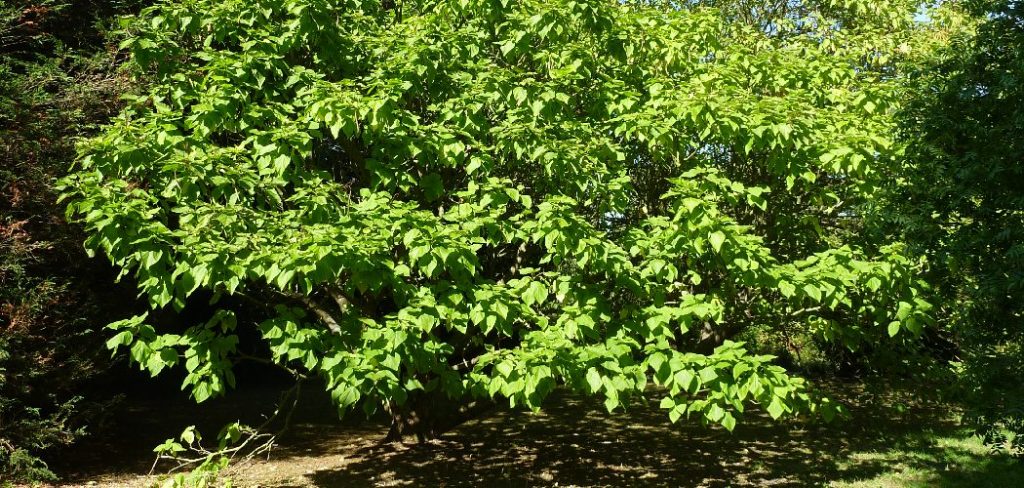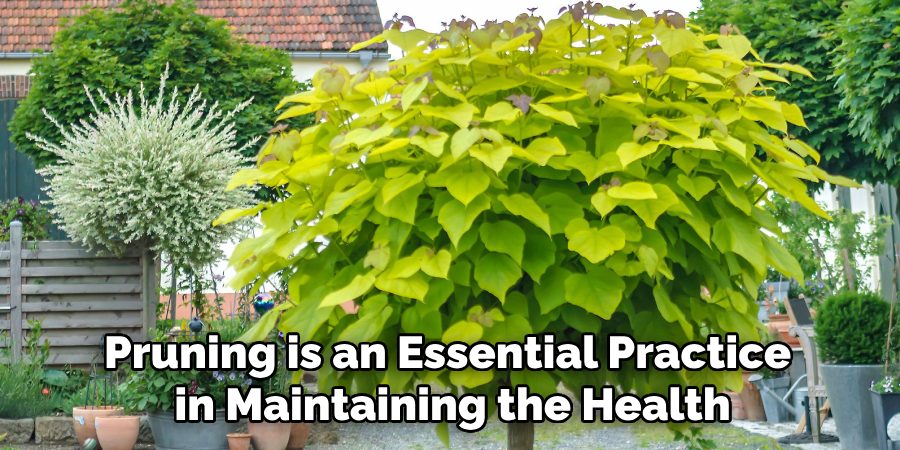Are you a proud owner of a catalpa tree and wondering how to keep it healthy and well-maintained? Don’t worry, pruning a catalpa tree is not as daunting as it may seem.
Pruning a catalpa tree is an essential step in maintaining its health, shape, and overall appearance. Known for their large leaves and striking blossoms, catalpa trees can grow quite rapidly, making regular pruning vital to prevent overgrowth and keep the tree well-balanced. Proper pruning not only enhances the tree’s natural beauty but also helps to remove dead or diseased branches, promoting healthier growth.

By understanding the best practices and timing for pruning, you can ensure your catalpa tree thrives and remains a stunning feature in your landscape. Let’s explore some tips and techniques on how to prune catalpa tree.
What Are the Benefits of Pruning a Catalpa Tree?
Pruning a catalpa tree offers several benefits for both the health and appearance of the tree. Here are some reasons why pruning is important:
- Promotes Healthier Growth: Removing dead or diseased branches allows the tree to focus its energy on new growth, improving overall health and vitality.
- Enhances Visual Appeal: Pruning helps to maintain a balanced and aesthetically pleasing shape for your catalpa tree.
- Increases Air Circulation: Trimming away dense foliage can improve air circulation around the tree, reducing the risk of fungal diseases.
- Prevents Hazards: Removing weak or damaged branches can prevent potential hazards such as falling limbs that could cause property damage or harm to people.
- Encourages Fruit Production: If you have a fruit-bearing catalpa tree, proper pruning can help to increase the yield of fruit by promoting new growth and reducing disease.
What Will You Need?
To properly prune a catalpa tree, you will need the following tools:
- Hand pruners for smaller branches (up to 1 inch in diameter)
- Loppers for larger branches (1-2 inches in diameter)
- Pruning saw for thicker branches (more than 2 inches in diameter)
- Safety gear, including gloves, safety glasses, and a sturdy ladder if needed
- Disinfectant spray or rubbing alcohol to sterilize your tools between cuts
Once you have gathered all your tools, you are ready to begin pruning your catalpa tree.
10 Easy Steps on How to Prune Catalpa Tree
1. Assess the Tree
Begin by thoroughly examining the catalpa tree to identify areas that require pruning. Look for any dead, diseased, or damaged branches, as these should be your priority for removal. Inspect for crossing or rubbing branches, as they can lead to wounds and weaken the tree over time. Additionally, check for suckers around the base of the tree or water sprouts along the main trunk and branches, as these unwanted growths can divert energy from the tree and should be removed. Assess the overall shape and canopy of the tree, ensuring that it remains balanced and aesthetically pleasing.

2. Remove Dead or Diseased Branches
Dead or diseased branches can pose a significant risk to the overall health of your tree and the safety of its surrounding environment. These branches are often brittle and prone to breaking, which can cause damage to property or injury to people and animals nearby. Carefully inspect the tree for branches that show signs of decay, such as discoloration, a lack of healthy leaves, or visible fungal growth. If a branch is diseased, it’s crucial to remove it promptly to prevent the spread of infection to other parts of the tree. When cutting these branches, make clean cuts just outside the branch collar to encourage proper healing and minimize harm to the tree.
3. Eliminate Crossed or Rubbing Branches
Crossed or rubbing branches can cause significant damage to trees over time. When branches rub against each other, they create wounds in the bark, leaving the tree vulnerable to pests and diseases. Identifying and removing one of the crossed branches is essential to prevent long-term harm. Choose the less healthy or poorly positioned branch to prune, ensuring the remaining branch has enough space to grow freely. Conduct these cuts with precision and proper tools to promote healthy growth and maintain the tree’s structural integrity.
4. Thin the Canopy
Thinning the canopy is a crucial step in tree maintenance that helps improve airflow and sunlight penetration throughout the tree. This process involves selectively removing smaller branches or sections of dense growth to reduce overcrowding and promote a healthy balance of foliage. Proper thinning minimizes the risk of fungal diseases by allowing moisture to evaporate more quickly and ensures that the tree’s energy is directed towards its strongest and healthiest branches. Take care not to over-prune, as excessive thinning can weaken the tree and disrupt its natural growth patterns. Aim for a balanced structure that supports the tree’s overall health and stability.

5. Trim for Shape and Structure
Trimming for shape and structure is an essential aspect of maintaining a tree’s overall health and appearance. This process involves selectively cutting branches to create a balanced and visually appealing form while ensuring the tree remains structurally sound. Focus on removing any crossing branches, as well as those growing inward or at awkward angles, to maintain a clean and open canopy. Additionally, consider the tree’s natural growth pattern when shaping it, as forcing an unnatural form can weaken its structure over time.
6. Cut at the Right Angle
When pruning, make sure to cut at the correct angle to promote proper healing and prevent damage to the tree. Aim to make cuts just outside the branch collar, which is the swollen area at the base of the branch where it connects to the trunk or a larger branch. Cutting at this angle allows the tree to close the wound effectively and reduces the risk of disease or pest infestations. Avoid cutting too close or leaving a stub, as this can impede the tree’s natural ability to recover. Always use sharp, clean tools to ensure smooth cuts and to minimize harm to the tree.
7. Avoid Excessive Pruning
While pruning is essential for maintaining a healthy and aesthetically pleasing tree, excessive pruning can do more harm than good. Removing too many branches at once can weaken the tree, reducing its ability to photosynthesize and store energy. Over-pruning can also leave the tree vulnerable to pests, diseases, and sunscald, as it removes the protective canopy. A general rule of thumb is to never remove more than 25% of a tree’s foliage in a single pruning session. Always assess the tree’s overall health and growth before deciding how much to prune, and consider spreading out significant pruning over multiple seasons to avoid stressing the tree.

8. Dispose of Pruned Material
Properly disposing of pruned material is essential for maintaining a tidy and healthy environment. Start by gathering all branches, leaves, and other debris created during the pruning process. Depending on the volume and local regulations, you can compost smaller branches and green waste to create nutrient-rich mulch for your garden. Alternatively, arrange for yard waste collection services or take the material to a designated recycling center. For larger branches and wood, consider repurposing them as firewood or wood chips if suitable.
9. Monitor the Tree
Regular monitoring of the tree after pruning is essential to ensure its health and proper growth. Check for any signs of disease, pests, or stress, such as discolored leaves, unusual growth patterns, or fungal growth on the trunk. Address any issues promptly by consulting a tree care professional or applying appropriate treatments. Additionally, observe the tree’s growth over the seasons to ensure it is adapting well to the pruning. Keeping a close eye on the tree allows you to take proactive measures, ensuring its long-term vitality and beauty.
10. Prune Regularly
Pruning is an essential practice in maintaining the health, shape, and strength of a tree. Regular pruning helps remove dead, damaged, or diseased branches, preventing them from affecting the overall structure of the tree. It also allows sunlight and air to reach inner branches, promoting healthier growth. When pruning, ensure to use clean, sharp tools and make precise cuts to minimize stress on the tree. The ideal time to prune varies depending on the species, but it is commonly done during the tree’s dormant season.

By following these best practices, you can keep your trees healthy and thriving for years to come.
5 Things You Should Avoid
- Over-pruning: Removing too many branches at once can stress the catalpa tree and hinder its growth. Stick to removing no more than 25% of the canopy at a time.
- Pruning in the Wrong Season: Avoid pruning during the growing season, especially late spring or summer, as this can make the tree more vulnerable to pests and diseases. Instead, prune during the dormant season for best results.
- Using Dull or Dirty Tools: Cutting with unclean or blunt tools can create jagged wounds and increase the risk of infections. Always ensure your tools are sharp and sanitized before pruning.
- Cutting Too Close to the Trunk: Never make flush cuts near the main trunk, as this can damage the bark and lead to decay. Leave a small collar of wood to aid in proper healing.
- Ignoring Dead or Diseased Branches: While over-pruning is harmful, failing to remove dead, dying, or diseased branches can spread problems to healthy parts of the tree. Address these areas carefully to protect the tree’s overall health.
Conclusion
How to prune catalpa tree requires careful planning and proper technique to ensure the tree remains healthy and aesthetically pleasing.
Always start by identifying and removing any dead, diseased, or dying branches, as these can compromise the tree’s overall well-being. Be mindful of seasonal timing, with late winter or early spring typically being the best period for pruning. Avoid excessive cuts or cutting too closely to the trunk, as these mistakes can hinder the tree’s natural healing process.
By following these guidelines and using sanitized tools, you can effectively prune your catalpa tree, encouraging robust growth and long-term vitality.
About
Jennifer Branett is a distinguished figure in the world of Garden design, with a decade of expertise creating innovative and sustainable indoor solutions. His professional focus lies in merging traditional craftsmanship with modern manufacturing techniques, fostering designs that are both practical and environmentally conscious. As the author of garden, Jennifer delves into the art and science of garden-fix, inspiring artisans and industry professionals alike.
Education RMIT University
(Melbourne, Australia) Associate Degree in Design (Jennifer Branett) Focus on sustainable design, industry-driven projects, and practical craftsmanship. Gained hands-on experience with traditional and digital manufacturing tools, such as CAD and CNC software.
Nottingham Trent University
(United Kingdom) Bachelor’s in Garden and Product Design (Honors) Specialized in product design with a focus on blending creativity with production techniques. Participated in industry projects, working with companies like John Lewis and Vitsoe to gain real-world insights.Publications and Impact
In indoor, Jennifer Branett his insights on Garden design processes, materials, and strategies for efficient production. His writing bridges the gap between artisan knowledge and modern industry needs, making it a must-read for both budding designers and seasoned professionals.
